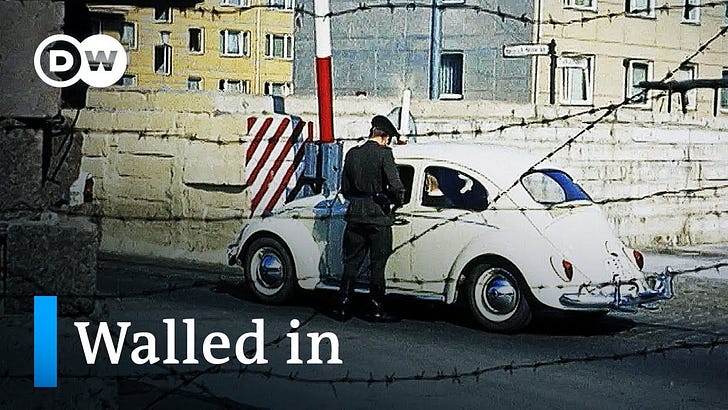We Have Met the Oppressor and He is Us
Part II of an essay exploring the ideological source of the modern totalitarian state
Welcome back. In Part I, we discovered that the original Communist slogan “Workers of the World Unite” and the modern “We Believe” yard sign mean something very different from what the words actually say. In Part II, we’ll find out that the modern “anti-fascist” movement must invent domestic enemies to exist.
Where were you on New Year’s Eve 1989?
I was in Texas, getting ready to move to California, ignorant of the fact that East and West Germans were cheering wildly as David Hasselhoff stood on a crane above Berlin’s Brandenburg Gate and belted out his #1 song “Looking for Freedom.”
In early November, Berliners had breached the 12-ft.-high Anti-Fascist Protection Rampart that had “protected” Communism for 28 years. Egon Krenz, the last Socialist Unity Party chairman of East Germany, said “it was the worst night of my life.”
On June 15, 1961, the first Socialist Unity Party chairman, Walter Ulbricht, told the international media “no one has the intention of erecting a wall.” On August 11, the Ministry for State Security (the Stasi) launched Operation Rose, informing its agents “today we begin a new phase of our Chekist work … steps are being taken to end desertion from the republic.”
And on August 12, Ulbricht signed the order to build the wall, which was actually two separate walls with a “Death Strip” in between. Covered with sand or gravel, footprints were easy to spot, and the strip gave East German guards a clear line of fire toward their fellow citizens trying to “desert” the Communist utopia.
According to the now-public East German archives, the Stasi and the Death Strip prevented over 90% of attempted escapes, and everyone coming in from West Berlin was under surveillance by the 7,600-member Department for Passport Control and Person-Tracking. Posing as simple immigration agents, their secret mission was to gather intelligence on every single person entering the country.
West Germany officially recognized East Germany in 1972. Travel across the border was normalized, but the wall stayed up. In a documentary released in 2021, former Stasi major Gunter Enterlein told filmmakers, “On the one hand, the wall had to remain psychologically and physically intact. On the other hand, we wanted to present ourselves to the world as open-minded.”
By 1980, the year I graduated high school in the UK, the Stasi had 80,000 employees and the country had been converted into a total surveillance state. “Many ordinary citizens helped to keep watch,” Enterlein said. “Who was leaning toward the West? Who could be thinking about leaving? Who was in touch with whom?”
Wolfgang Schwanitz, a former Stasi Lt. General, told filmmakers another part of the job was “to compensate for the deficits” of the country’s political leaders. In another age, he might have been the Director of the FBI.

One year after construction of the wall began, armed guards of the German Democratic Republic shot teenager Peter Fechter in the pelvis to protect him from being infected by the values of the West.
“His body lay tangled in a barbed wire fence and he bled to death in full view of the gathering media,” reported NBC News on the 50th anniversary of the wall in 2011. “American soldiers could not rescue him because he fell a few yards within the Soviet sector.”
How Did We Get Here From There?
When America won the Cold War and defeated Communism, the #1 ballad in Europe was “Looking for Freedom.” So how did America wind up in a world where former New York City Mayor Mike Bloomberg says Democrats are Communists, and Democrats agree with Socialists that Freedom is Fascism?
The popularity of Communist propaganda discussed in Part I of this essay is part of the answer, but there is also the question of how such propaganda managed to gain a foothold in the American mind, and why that appeared to happen so quickly.
The short answer is that it did not happen quickly. Within the reasonable space of a newsletter, I will try to offer a longer answer.
The first thing to remember is that Nazism, aka National Socialism, died a well-deserved death in 1945, but Communism, or International Socialism, burned out and surged back to life in less than 50 years.
For instance, I was born in 1961, the year the Berlin Wall was erected.
In 1965, my father was flying the F-100D Super Sabre out of Hanh Air Force Base in Germany as a deterrent to — as Vladimir Nabokov called it — “Russia and her embarrassing tumors.” As my father wrote in a recent memoir, “There were ten fighter squadrons in Germany, at four different bases. All had the same role: to deter the Soviet Union from attacking Western Europe.”
In 1966, my mother was getting a pair of dressage riding boots made by a German company that had been compromised by the KGB.
In 1976, my family was watching the Montreal Olympics from Norway as doped-up East German women stole a gold medal from Enith Brigitha, the first black swimmer to medal at the Olympic Games. The American media’s response was to call American Shirley Babashoff a “surly loser.”
In 1980, I graduated from London Central High School. Now closed, the school was located at RAF High Wycombe.
In December 1989, I got married and the Berlin Wall fell.
On Christmas Day 1991, the Union of Soviet Socialist Republics ceased to exist and the world celebrated.
Where is Here?
Less than a decade after that 2011 anniversary “group hug against the Communist surveillance state,” Americans were electing so-called Democratic Socialists to Congress, Workers World was praising The Squad’s “revolutionary understanding” of America, the Democratic Party was being infiltrated by out-and-out Communists, and San Francisco elected a District Attorney who had literally worked for a Communist dictator.
With a coup de grace worthy of the Stasi, the 2016 Hillary Clinton campaign paid a foreign agent to provide fake Russian intelligence that Donald Trump was “owned” by a former Soviet KGB agent (whose final post was in Dresden, East Germany), and the same Corporate Democrat Media Complex that had mourned the shooting of Peter Fechter was fully engaged in a conspiracy with high-level U.S. government officials to accuse the President of the United States of treason. (Update: The video linked below documents Dresden in the 1960s, but is no longer available.)
But before that, Americans were flirting heavily with men who praised Cuban healthcare, Venezuelan schools, and Soviet transportation, and “blasted the way the United States had intervened in other countries.”
All of this happened as the Democratic Party veered sharply toward Socialism, even as “alarmists” (like yours truly) warned of distinct similarities to the Russian Social-Democratic Workers Party — which carried out the Bolshevik Revolution of 1917 and only then changed its name to the Russian Communist Party.
In 1918, Lenin wrote in The Proletarian Revolution and the Renegade Kautsky that “proletarian democracy is a million times more democratic than any bourgeois democracy; Soviet power is a million times more democratic than the most democratic bourgeois republic.”
Knowing full well that the “democracy” Lenin brought to life was in fact a murder cult, hard-left Democratic Socialists of America say with a straight face that America’s democratic bourgeois republic is a fiction built on racism, and “working people [the proletariat] should run both the economy and society democratically to meet human needs.”
They’re even quoting Marxist revolutionary Leon Trotsky, who died with a Marxist ice pick in his skull: “The proletariat cannot attain power within the formal limits of bourgeois democracy, but can do so only by taking the road of revolution.”
In July 2021, Mark Bonkowski wrote in the Toronto Sun that Canadian Prime Minster Justin Trudeau “if re-elected to the predicted majority, will continue on the path towards socialism and a communist dependency upon the state.”
A few months later, in February 2022, the Trudeau government invoked the Emergencies Act to keep people safe from the “misogynistic, racist, women-haters, science-deniers” of the “Freedom Convoy,” accused a Jewish conservative MP of “standing with people who wave swastikas,” ordered banks to seize private donations to his political opponents, and finally revoked the Emergencies Act to “keep people safe.”
The “formerly militant” Socialist Party of the UK praised Trudeau’s actions while also claiming the trucker protest had “left both the main establishment Liberal and Conservative parties looking crumpled.”
The World Socialist Web Site wrote, without irony, “History has shown time after time that the strengthening of the capitalist state apparatus in the name of ‘defending democracy’ or combatting ‘fascism’ invariably results in stepped-up repression directed against the working class.”
Thus, 31 years after the Berlin “Anti-Fascist Protection Rampart” fell, my daughter says she’s a Socialist without realizing that the goal of Socialism is Communism, Putin is trying to rebuild the USSR, Communist China hosted the Olympic Games and shared American intelligence with Russia on the eve of Putin’s invasion of Ukraine, and President Joe Biden is poised to either ignore or stamp out the blue-collar “People’s Convoy” that — as I write this — is headed to Washington DC.
Whether you like David Hasselhoff or hate him, no one can deny that much of the world has gone from Looking for Freedom in 1989 to Freedom is Fascism in 2022.
We Have Met the Oppressor, and He is Us
No matter what your great-grandfather’s socialism looked like, today’s socialism is neither national nor international. It is an amalgamation of the two, and it looks more like fascism than any socialist dares to admit.
International Socialism seized the means of production and — at the point of a gun — handed it to the workers. The workers had little idea how to manage the means of production, so a central committee of workers micromanaged it for all.
National Socialism left the means of production in corporate hands, but bent those hands — at the point of a gun — to the government’s will.
Modern socialism, noting that fascism was more efficient than communism, settled on the “post-totalitarian” system described by Vaclav Havel.
“In highly simplified terms,” Havel wrote, “it could be said that the post-totalitarian system has been built on foundations laid by the historical encounter between dictatorship and the consumer society.”
The Nazi and Soviet systems were propped up, in part, by citizens who both willingly and unwillingly informed on one another, either because they were true believers or they would be sent to a prison camp if they didn’t. Our modern post-totalitarian system is enabled by swarms of social media users who voluntarily organize themselves to inform each other about fascists like Dave Chappelle and Patton Oswalt.
“Who is leaning toward the West?” our modern activists ask. “Who is thinking about leaving the movement? Who is in touch with whom?”
Just a few short years ago, no one could possibly have predicted that one of America’s most celebrated black comedians would be called a racist by World Socialists, or that the Prime Minister of Canada would defame a Jewish Member of Parliament as “standing with people who wave swastikas.”
These are only two recent examples, but they represent a serious escalation in the tactics of the “anti-fascists.” When a movement must invent domestic enemies to exist, its activists are utterly comfortable doing so, and heads of state join the mob, the next escalation can only go one of two ways: utter collapse or the triumph of the will.
While the proletariat swarms use private entities like Twitter to organize, Twitter itself does the will of the political majority by censoring news harmful to the election of Joe Biden (see Hunter’s Laptop). Similarly, GoFundMe and private banks do the will of Justin Trudeau by seizing private funds donated to political protesters.
Private companies enabling the oppression of their fellow citizens insist they are only fulfilling their Community Standards or Civic Integrity Policy, and their actions can’t be oppression because they are both supported by the community and taken on behalf of the community.
Havel’s audience had been oppressed by a real-life totalitarian regime. But if you read his description of their behavior without any context, you might rightly conclude he was talking about the actions of our modern activists, who have:
created a “general norm” of “bringing pressure to bear on their fellow citizens”;
learned to identify with the mob “as though it were something natural and inevitable”;
“with no external urging, come to treat any non-involvement as an abnormality, as arrogance, as an attack on themselves.”
The government is not oppressing you, they say. Private corporations do not have to protect free speech. You have freedom of speech, but not freedom from its consequences. We’re just upholding Facebook’s Community Standards. If we don’t enforce the consequences, Democracy Dies in Darkness. If you don’t join us in doing it, your silence is violence, they say.
“So where is the totalitarianism?” they ask. They might as well be saying publicly that “no one has the intention of erecting a wall” while saying privately “today we begin a new phase of our Chekist work.”
As Havel points out, this is “a world of appearances trying to pass for reality.”
“The post-totalitarian system touches people at every step, but it does so with its ideological gloves on,” Havel says. “This is why life in the system is so thoroughly permeated with hypocrisy and lies: government by bureaucracy is called popular government … depriving people of information is called making it available … arbitrary abuse of power is called observing the legal code … the lack of free expression becomes the highest form of freedom … farcical elections become the highest form of democracy … banning independent thought becomes the most scientific of world views.”
Havel’s original list of lies is longer, but every one of his observations can be seen at work in the 21st century; and not just in countries run by dictators like Vladimir Putin, but in the heart of western democracies, the United States and Canada.
The worst part about this system is that we don’t even need to accept the lies to be governed by them. As Havel says, “It is enough for [us] to have accepted [our] life with it and in it. For by this very fact, individuals confirm the system, fulfill the system, make the system, are the system.”
Democratic Socialists are fond of dividing the world into oppressor and oppressed, but the truth is more banal: we have met the oppressor, and he is us.
The Good Guys Have Already Won
The good news according to Sarah Hoyt is that we, the good guys, have already won.
We have won, because reality fights on our side. As it’s been increasingly obvious, these people don’t understand how anything works, beyond perhaps academic politics, and they keep trying to bring to life models that can’t and won’t work.
We, who are not globalists are winning and will ultimately win. A great fracturing is taking place. And the big conglomerate of the left will try very hard to impose their nonsense on us and fail.
The bad news is that “what comes next is not won.”
In most of the world, it won’t be the American model as it’s supposed to be. They never understood (and don’t wish to understand) our Constitution, for instance.
Will it be a return to a constitutional republic here. Well, one can hope and fight for it, but the chances are actually vanishingly small.
History is marching on, my friends. The history presented in this essay reveals that the “anti-fascists” are, in fact, pro-totalitarians. What we do with that knowledge is up to us. In this house, we believe we have not yet begun to fight.
Author’s Note: I began Part II with the intent of discussing the intellectual predecessors of Vaclav Havel, who were trying to figure out from what bloody hell the ideology of the modern totalitarian state emerged. But I thought the recent events in Canada warranted further proof that North America has officially arrived in Havel’s post-totalitarian world of 1978. In Part III, we’ll get to the root of the matter: Who is the American Rousseau, and why is he taking us “forward” to 1762?




